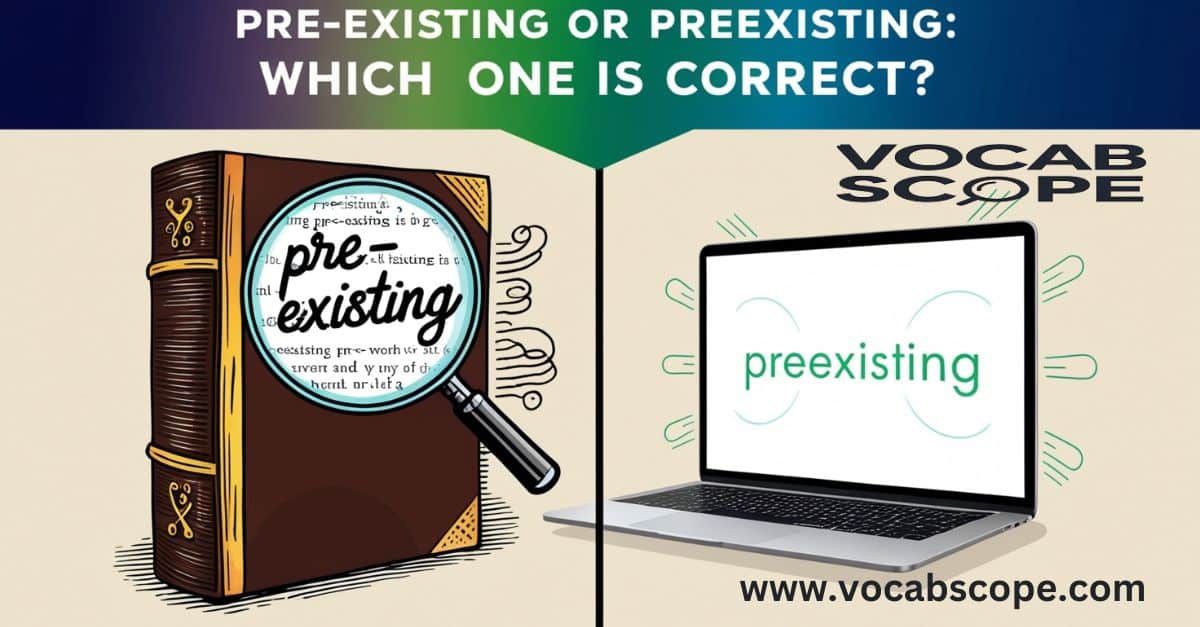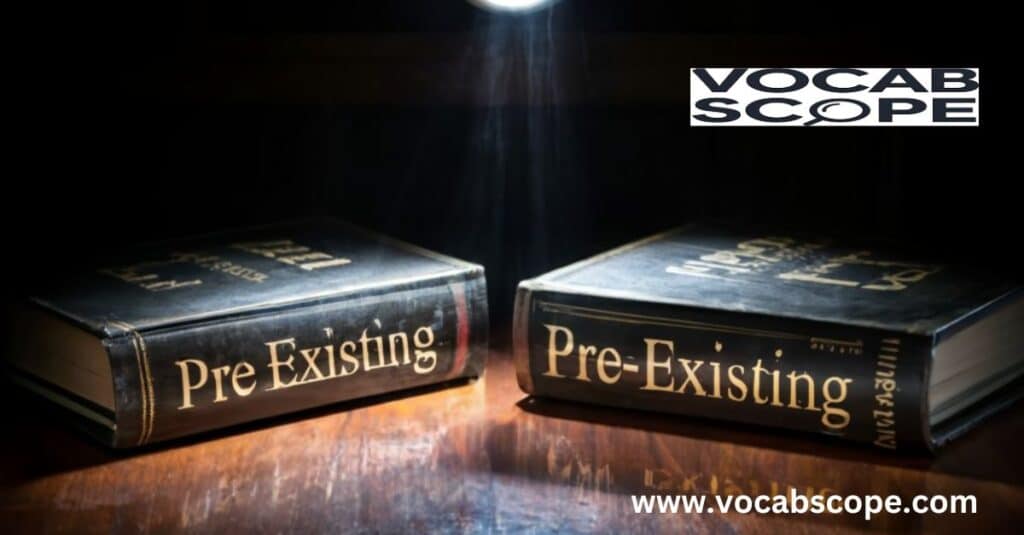Navigating the English language can sometimes feel like wandering through a maze, especially when it comes to terms that seem almost interchangeable. One such pair of terms is “pre-existing” and “preexisting.”
If you’ve ever found yourself puzzled over which form to use, you’re not alone. Let’s delve into this topic and clarify the nuances.
Why is there Confusion?
The confusion stems from the ever-evolving nature of the English language. As our language grows and changes, so do the rules governing its use. The prefixed word “pre-existing” (or “preexisting”) is a prime example of this evolution in action.
Compound words often start their journey in language as two separate words. Over time, they may become hyphenated, and eventually, they might merge into a single word. This process isn’t uniform across all words, leading to inconsistencies and, consequently, confusion.
Consider these examples:
- E-mail → email
- To-day → today
- Web site → website
Each of these words has undergone a similar transformation, but at different rates and times. This lack of uniformity is precisely why “pre-existing” and “preexisting” coexist in modern English.
Factors Contributing to the Confusion:
- Hyphenation: The presence or absence of a hyphen can change the way we perceive a term.
- Style Guides: Different style guides have varying preferences for hyphenated and closed forms.
- Contextual Use: Certain environments or audiences may lean toward one form.
What do ‘Pre-Existing’ or ‘Preexisting’ Mean?
Both “pre-existing” and “preexisting” refer to something that exists prior to a certain point in time or prior to an event.
Definitions:
- Pre-Existing: This form suggests an established condition or status before a particular event.
- Preexisting: The closed form conveys the same meaning but is often preferred in more modern usage.
Example in a Sentence:
- “The patient had a pre-existing condition that complicated the surgery.”
- “Her pre-existing knowledge of the topic gave her an advantage in the discussion.”
“Pre-Existing” or “Preexisting”: Which One Should Be Used?

Choosing between these forms depends largely on your audience, context, and the style guide you’re adhering to.
Must Read: Agreeance vs Agreement: Which One to Use?
When to Use Each Form:
- Pre-Existing:
- Preferred in more formal writing, such as legal documents or academic papers.
- Recommended by traditional style guides for clarity.
- Preexisting:
- Gaining traction in casual writing or digital content.
- Commonly used in contemporary literature and media.
Summary Table: Usage Preferences
| Context | Preferred Form |
| Legal Writing | Pre-Existing |
| Academic Papers | Pre-Existing |
| Digital Content | Preexisting |
| Casual Writing | Preexisting |
Style Guides and Consistency
When writing, it’s essential to adhere to established style guides for consistency. Here’s a brief overview of some well-known guides and their preferences regarding hyphenated and closed forms.
Common Style Guides:
- APA Style: Generally favors closed compounds unless clarity demands hyphenation.
- Chicago Manual of Style: Typically prefers hyphenation for clarity.
- MLA Style: Allows both forms but encourages consistency throughout the document.
By following these guidelines, you maintain clarity and ensure that your writing is both coherent and professional.
Readability and Clarity
Readability is key in effective communication. Whether you choose “pre-existing” or “preexisting,” ensure your writing remains clear. Hyphenated forms can enhance clarity in certain contexts by breaking up complex phrases, while closed forms may feel more modern and streamlined.
Tips for Maintaining Readability:
- Keep sentences concise and to the point.
- Avoid jargon unless necessary; simplicity often enhances understanding.
- Use headings and lists to break up text and guide the reader.
Audience and Context
Consider your audience when deciding which form to use. In more formal settings, such as academic or professional writing, opting for “pre-existing” may resonate better. Conversely, in blogs or social media, “preexisting” could feel more approachable.
Audience Considerations:
- Professional Settings: Lean towards “pre-existing.”
- Casual Conversations or Blogs: “Preexisting” might be more fitting
Origins of the Word “Pre-Existing” or “Preexisting”
“Pre-Existing”
The term “pre-existing” has an interesting etymology that sheds light on its meaning. Let’s break it down.
Breakdown of the Components
- Prefix “Pre-“:
- Origin: The prefix comes from the Latin word “prae,” which means “before” or “prior to.”
- Usage: It appears in various English words like “predate” (to exist or occur before) and “prejudice” (to form an opinion before having full knowledge).
- Root “Existing”:
- Origin: The root comes from the Latin verb “existere,” which means “to stand out” or “to arise.”
- Usage: In English, “exist” refers to having actual being or reality.
Meaning Derived from Etymology
Putting these parts together, “pre-existing” literally means “existing before.” This reflects the term’s usage in various contexts, such as health, contracts, and legal matters, where it denotes something that was in place prior to a specific event or circumstance.
Historical Context
The usage of the term can be traced back to legal and medical contexts, where specifying conditions that exist prior to an agreement or diagnosis is crucial. For example, in health insurance, “pre-existing conditions” refer to medical issues that existed before a person obtained coverage, often impacting eligibility and costs.
“Preexisting”
The term “preexisting” has its roots in a combination of Latin elements, similar to its hyphenated counterpart. Let’s explore its etymology and how it has evolved in the English language.
Don’t Miss To Check Out: Pre vs Post: Which Prefix to Use?
Breakdown of the Components
- Prefix “Pre-“:
- Origin: This prefix comes from the Latin “prae,” meaning “before” or “prior to.”
- Usage: It’s common in various English words, such as “premature” (occurring before the expected time) and “preempt” (to act before someone else does).
- Root “Existing”:
- Origin: The root derives from the Latin verb “existere,” which means “to stand out” or “to arise.”
- Usage: In English, “exist” refers to having actual being or presence.
Meaning Derived from Etymology
Combining these parts, “preexisting” translates to “existing before.” This encapsulates its meaning in contexts like health, contracts, and legal discussions, where it denotes conditions or states that were in place prior to a specific event or agreement.
Historical Context
The term “preexisting” has gained prominence particularly in fields such as insurance and law. In health care, for example, “preexisting conditions” refer to medical issues that were present before a patient’s health insurance coverage began. This usage is crucial for determining eligibility and coverage options.
Examples in Context “Pre-Existing” or “Preexisting”:
“Pre-Existing”:
The term “pre-existing” appears frequently across various fields. Here are some practical examples that illustrate its use in different contexts.
1. Health Insurance
- Sentence: “The policy does not cover any pre-existing conditions, meaning any health issues you had before the coverage began.”
- Context: In the health insurance industry, this phrase is crucial for understanding coverage limits and eligibility.
2. Contracts
- Sentence: “The agreement is null and void if it conflicts with any pre-existing contracts between the parties involved.”
- Context: In legal discussions, specifying pre-existing contracts helps clarify obligations and avoid misunderstandings.
3. Real Estate
- Sentence: “The buyer was concerned about any pre-existing structural issues in the house before making an offer.”
- Context: In real estate transactions, potential buyers often investigate any pre-existing problems to make informed decisions.
4. Software Development
- Sentence: “Our application was designed to integrate with pre-existing systems to ensure a seamless user experience.”
- Context: In technology, referring to pre-existing systems indicates compatibility and the need for smooth integration.
5. Environmental Studies
- Sentence: “The researchers evaluated the pre-existing conditions of the ecosystem before starting their restoration project.”
- Context: In environmental science, understanding pre-existing conditions is vital for effective restoration efforts
“Preexisting”:
The term “preexisting” is used in various fields to denote conditions or situations that existed before a specific point in time. Here are some practical examples showcasing its application.
1. Health Insurance
- Sentence: “Many people struggle to find coverage for their preexisting conditions, as insurers often impose waiting periods.”
- Context: This is particularly relevant in discussions about health care, where understanding coverage for medical issues that existed before the policy is critical.
2. Legal Agreements
- Sentence: “The preexisting legal obligations must be honored to avoid any conflicts in the new contract.”
- Context: In legal contexts, referring to preexisting obligations helps clarify responsibilities and ensure compliance with prior agreements.
3. Technology Integration
- Sentence: “The software was developed to work with preexisting databases, facilitating a smoother transition for users.”
- Context: In tech development, using preexisting systems indicates the software’s compatibility and the importance of seamless integration.
4. Academic Research
- Sentence: “The study examined preexisting literature on climate change to frame its hypotheses.”
- Context: In academia, referring to preexisting research helps establish a foundation for new studies, showing the continuity of knowledge.
5. Building Renovations
- Sentence: “Before starting renovations, the contractor assessed the preexisting conditions of the structure to identify any necessary repairs.”
- Context: In construction, understanding preexisting conditions is essential for planning and ensuring safety.
Synonyms for “Pre-Existing” or “Preexisting”

| Synonyms |
| Existing |
| Prior |
| Earlier |
| Established |
| Former |
| Previous |
| Antecedent |
| Aforementioned |
| Prevailing |
| Inherited |
| Preceding |
| Initial |
| Precedent |
| Proximate |
| Concurrent |
| Foundational |
| Introductory |
| Inceptive |
| Legacy |
| Conditioned |
Conclusion
In the debate between “pre-existing” and “preexisting,” context is key. While both forms convey the same meaning, your choice should reflect your audience, the medium, and adherence to relevant style guides. By considering factors such as readability, clarity, and context, you can make an informed decision that enhances your writing.
Remember, whether you go with “pre-existing” or “preexisting,” what matters most is that your writing communicates clearly and effectively. So, choose the form that best fits your style, and let your words shine!

“Robert Henry is an experienced blogger with a passion for language and education. His insightful posts on Vocab Scope offer readers valuable tips on vocabulary and grammar. With a background in linguistics and a knack for clear, engaging writing, Robert is dedicated to helping others enhance their communication skills.”






